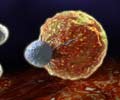Cancer immunotherapies that block the effects of a T-cell regulator called SLAMF6 may help the immune system destroy tumur cells.

‘Absence of SLAMF6 unleashes powerful anti-tumor T-cells, extending survival. These findings may have implications for cancer immunotherapy and could lead to the development of new melanoma treatments that target SLAMF6.’
Read More..




The new study in mice suggests that immunotherapies that turn off SLAMF6 might add an option that could be used alone or in combination with other immunotherapies to treat cancer more effectively.Read More..
"There is a real need to find new targets for immunotherapies," says lead author Emma Hajaj, an MD-PhD candidate at the Sharett Institute of Oncology at Hadassah Hebrew University Hospital, Jerusalem, Israel.
"We thought that SLAMF6, which is a receptor found on all T-cells, was a good candidate for immunotherapy, but more thorough research was needed to confirm this."
To investigate this further, Hajaj and her colleagues created a mouse model that enabled the team to understand the role of SLAMF6 in melanoma treatment. They found that tumors in mice treated with SLAMF6-lacking T-cells shrunk faster and stayed smaller than tumors in mice treated with typical T-cells.
Additionally, they saw that the expression of a gene called LAG-3 increased in the SLAMF6-lacking cells, possibly to make up for the loss of the regulator. Combining SLAMF6-lacking T-cells with an antibody that blocks LAG-3 also increased their tumor-shrinking effect.
Advertisement
"These findings may have important implications for cancer immunotherapy and could lead to the development of new melanoma treatments that turn off SLAMF6."
Advertisement








